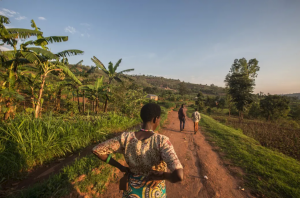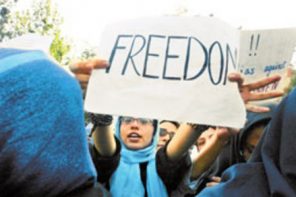When I and others wrote recently about a problematic study allegedly clarifying the number of women raped in Congo, there was a common refrain in the comments: All this talk about talking about rape, and nobody’s doing anything! What’s the point of arguing about the numbers?
I don’t subscribe to that view, for very many reasons, the primary one being that the one thing the heated conversations show is that numbers generate attention. There are reasons, for another time.
Meanwhile, here’s some news that has me feeling a little bit like the don’t-spend-time-arguing-it-out crowd: There’s a new “poll” that purports to tell me the worst place in the world to be a woman. And you know you have to put “poll” in quotes when the first quotation reacting to it, in the news article by the poll’s very funders is, “I’m completely surprised because I thought Somalia would be first on the list, not fifth.”
I heard about this on Newshour this morning, on the BBC, whose host referred to the poll as an “order of ghastliness.” That seems to get it about right.
Monique Villa, the CEO of Thomson Reuters, which conducted the poll — we’ll get back to that in a second — explained the methodology this way: More than 200 “gender experts” were asked to pick the world’s most dangerous countries for women, after considering six categories– health, sexual violence, non-sexual violence, “cultural and religious factors,” lack of access to education or other resources, and trafficking.
You read that right — this was the bright new idea of Reuters, one of the three top news wires in the world. The new “poll” launches the TrustLaw Women, a new section of a legal news wire run by the Reuters Foundation (ie, subscription free humanitarian news). TrustLaw says the experts were asked to consider “general perception of danger” in their rankings. Reuters’ TrustLaw also seems to feel that “aid professionals, academics, health workers, policymakers, journalists and development specialists” — who they list as their poll respondents — are all gender experts. I know a few people employed as gender experts who might disagree.
The poll literally began this way (pdf/methodology): “What in your opinion are the five most dangerous countries in the world for women?”
The level of non-information this poll represents is hard to overstate. A question like that tells us, at best, what a set of people perceive to be the most dangerous countries in the world. The headline for that poll is, “Afghanistan perceived by gender experts as most dangerous place to be a woman.” A measure of perception might be interesting in a conversation about how development workers, journalists or aid workers frame the world based on their opinions and biases. Or not.
That’s usually how polls are presented — with an acknowledgment that they are measuring perceptions. Here’s a few leads from Gallup’s website: “Americans’ satisfaction with the way things are going in the country fell to 20% in early June….Minnesota Rep. Michele Bachmann […] is currently recognized by 62% of Republicans nationwide…..The economy and unemployment nearly tied in Americans’ perceptions of the nation’s ‘most important problem’….” Gallup doesn’t say that the economy is Americans’ most important problem.
But the Trustlaw poll forgets it’s a poll; it thinks it’s a truth. “Violence, dismal healthcare and brutal poverty make Afghanistan the world’s most dangerous country for women, with Congo a close second due to horrific levels of rape, a Thomson Reuters Foundation expert poll said on Wednesday.”
The BBC Newshour also interviewed Madu Kishwa, founding editor of Manushi: A journal about women and society, who took umbrage at the fact that India was ranked fourth (worse than Somalia). Among her very impassioned and cogent arguments against the poll was this observation: “People build entire careers on atrocity-mongering.” Arguably the very kinds of people Reuters polled, in fact — including, of course, journalists.
Kishwa also pointed out that Indian Prime Minister Indira Gandhi was a woman. Villa responded by saying that Kishwa is right, “But it doesn’t bar the fact that 100 million women are involved in trafficking in India, and 50 million girls are missing, because of [female] infanticide” and the abortion of female fetuses.
Villa’s also right. But here’s the problem her charade of information does not resolve: How are you supposed to responsibly balance these truths against each other in order to determine how “bad” a place is? What’s the value of a female prime minister? At what rate does a female prime minister offset, to borrow a cliche about another part of the awful-to-be-a-woman world, a “rape epidemic”? And can you disassociate the value of a woman in a leadership role from the culture in which she retains that role? And if not, how do you quantify that value in a way comparable across cultural contexts? When girls are “missing” because of the abortion of female fetuses, and “missing” because they’ve been trafficked into sexual slavery across borders, are these the same kinds of missing?
The BBC host asked Villa a good question: “We do like these reports where countries rank things, because it gives us an excuse to feel we’re in control of the information. But isn’t the danger here that [when] you are making these big statements, these precise rankings, it undermines the bigger point here — that women as a whole still suffer tremendous and varied discrimination?”
Villa countered with, “It shows women face hurdles everywhere in the world.”
Really? Or does it actually just obfuscate and confuse, leaving us to argue about countries’ relative positions in the Order of Ghastliness?
I’m voting for the second one.
Updated. Thanks, savvy reader, for pointing out that women probably face hurdles, not hurdes.



